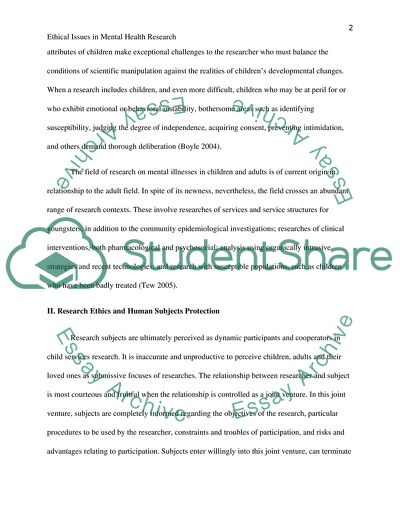
- Home
- Free Samples
- Premium Essays
- Editing Services
- Extra Tools
- Essay Writing Help
- About Us
- Studentshare
- Subjects
- Miscellaneous
- Research in mental health ethical issues
Research in mental health ethical issues - Essay Example

- Subject: Miscellaneous
- Type: Essay
- Level: Undergraduate
- Pages: 4 (1000 words)
- Downloads: 0
- Author: vchamplin
Extract of sample "Research in mental health ethical issues"
Researchers must deal with questions such as the following: “How is an appropriate balance between research risks and benefits achieved? How are members of high risk and vulnerable populations identified and recruited without violating their privacy or coercing their participation? How are the autonomy rights of children and adolescents protected when parental consent may or may not be in the child’s best interest? How is the researcher-participant confidentiality maintained when one learns that a child’s welfare may be in jeopardy?
” (Hoagwood et al. 1996, 135). It is surprising that there has been such a growing interest in ethical alternatives in the recent years. Perhaps modern moral treatises and awareness to ethical practices are indications of fundamental dilemmas in the operations of institutions whose objective has become growingly problematic. Moreover, difficult as these problems are for research involving human beings, when children and adults are the emphasis of the research, the uncertainties increase. Individual attributes of children make exceptional challenges to the researcher who must balance the conditions of scientific manipulation against the realities of children’s developmental changes.
When a research includes children, and even more difficult, children who may be at peril for or who exhibit emotional or behavioral instability, bothersome areas such as identifying susceptibility, judging the degree of independence, acquiring consent, preventing intimidation, and others demand thorough deliberation (Boyle 2004). The field of research on mental illnesses in children and adults is of current origin in relationship to the adult field. In spite of its newness, nevertheless, the field crosses an abundant range of research contexts.
These involve researches of services and service structures for youngsters, in addition to the community epidemiological
...Download file to see next pages Read MoreCHECK THESE SAMPLES OF Research in mental health ethical issues
Providing Mental Health Services
The need for public health ethical principles
The Health Education Code of Ethics
Ethical Issues in Gerontology
Minimizing Harm to Vulnerable Patients Participating in Research
Multicultural and Ethical Issues Dealing with the Court Systems
Ethical Issues in Undertaking Qualitative Research
Professional Standards in Mental Health Care

- TERMS & CONDITIONS
- PRIVACY POLICY
- COOKIES POLICY